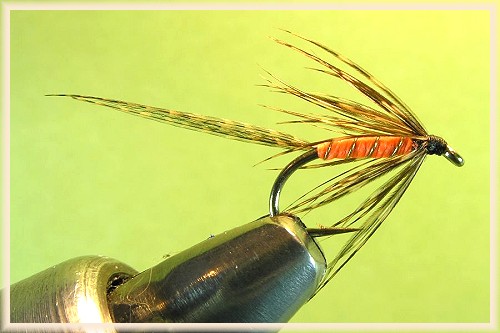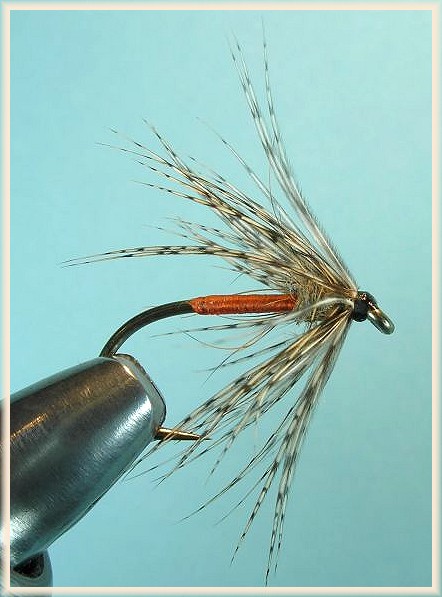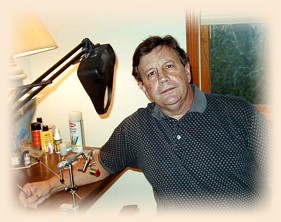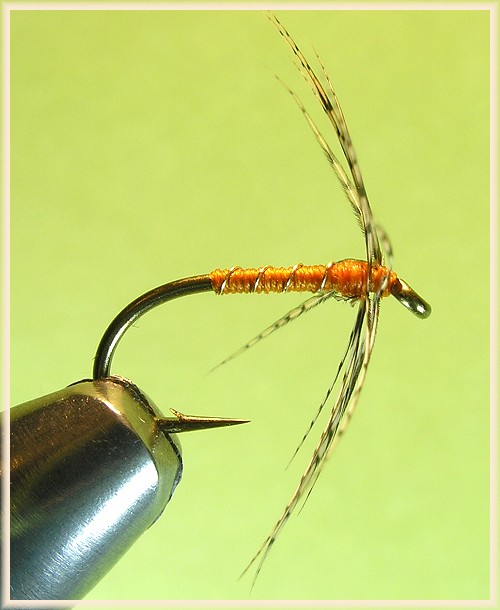There is a very fine history of the Orange Partridge that
has been previously done in Just Old Flies by John W.P.
Mooney, and it can be found here.
I felt that while his article was an excellent look at the
venerable Orange Partridge, of European origin, that there
was more to be said about this fly and the Partridge and
Orange. The first question that leaps to mind is, are they
the same fly? Well, I think in Europe the terms might be
used interchangeably, but here in the states they are,
in my mind at least, two quite different flies.
Let's first talk about the Orange Partridge. T.E. Pritt's
Yorkshire Trout Flies and North Country
Flies, published in 1865 and 1866 respectively,
defined the North Country wingless style of wet fly. This
is not to say that Pritt invented these flies, rather he
illustrated and catalogued them. The fly shown above is the
Orange Partridge listed among his 62 patterns. The fly
typifies the North Country style, in that it has very
sparse wings/legs, hackled here with Partridge, and a
spare body, made in this case of Pearsall's Gossamer silk
alone. Pritt specifies no rib, but the fly is very often
ribbed with gold wire. This is a very simple, very Spartan
fly, and can represent many things in the water, from nymphs
to pupae to emergers. The silk is typically not taken back
much beyond the hook point, in other words, the fly has a
short body. The hackle is not swept back much, and on some
flies is more or less straight up and down.

The second fly, shown above, is another Orange Partridge,
tied by Ireland's consummate professional tier Alice Conba.
It features Alice's trademark tail made of three strands
of bronze mallard flank, as well as a more swept back,
fuller hackle collar. This fly becomes much more a standard
wet fly in her version, and less a North Country Spider.
This might not be a bad thing in many circumstances, and
her customers have not complained about these changes.

The third fly I think of as more American, though I'm sure
there are European versions tied this way. This fly, like
Alice's, has a very full hackle collar, very swept back,
with a more noticeable head. Another difference is that
rather than using orange tying silk for the body, typically
the body is made from orange floss. The biggest difference
though, and what to me makes this fly a "Partridge and Orange"
vs. an Orange Partridge, is the thorax made of the darker fur
from a hare's mask. When I think of this version of the fly
I think of Dave Hughes, and the Partridge and Orange other
soft hackles shown in his books. It must be noted that there
are "hybrids," i.e., flies that don't fit into any of my neat
categories. For instance, I found a fly on-line that has a
Pearsall's Gossamer body, and a hare's mask thorax. There
are no absolutes here. Surprisingly, actually stunningly
to me, the Partridge and Orange or Orange Partridge receive
absolutely no mention at all in either Trout
by Ray Bergman or Mary Orvis Marbury's Favorite Flies.
The Partridge, Orange as it's listed in Flies
by J. Edson Leonard, seems to be a different fly still, with
an orange dubbed body and golden pheasant tippet tail. The
Partridge and Orange appears to be a fly whose popularity has
resurfaced post 1950, probably due to the efforts of Hidy,
Leisenring, and more recently Sylvester Nemes.
Though many believe that the proper way to tie the fly is
the North Country sparse, spare, spider way, I'm going to
make a bit of an argument here for tying it in the more
American style, at least under certain circumstances. I was
recently having a conversation with the owner of Mad River
Outfitters, our Columbus, OH, Orvis store, concerning soft
hackles in general. Brian Flechsig informed me that he ties
all his soft hackles with very full collars, swept back. Just
before fishing them, he treats them with Frog's Fanny and then
fishes them deep in the water column, like a nymph, with a
lift at the end. Aided by the Frogs Fanny, the fly traps air
bubbles, and gives a very lifelike imitation of hatching nymphs,
caddis pupa, and various emergers. He swears by this technique,
and has even gone so far as to educate some Western guides, who
have picked it up and made good use of it in Montana, Utah,
and other Western states. This puts me in mind of Gary
Lafontaine's observations of caddis pupae, and his Deep Sparkle
Pupa fly. The modern day "flymph" is designed to capture and
retain air bubbles as well.
I'm going to relate one more way to fish the Partridge and Orange,
one that I used under quite desperate circumstances on our Mad
River one day. I had just tied some American-style Partridge
and Orange flies in about size 12 the day before, and was out
on the river. There was a fish rising sporadically, in quite
a splashy way, about every 5 or ten minutes. I thought he might
be going after caddis, so I floated a number of dry flies over
him, to no avail, and then tried my Partridge and Orange flies
fished wet, with no success there either. I couldn't understand
this, because I found some dead insects in the water that were
large, and looked like my Partridge and Orange flies. I'm still
not sure what they were, maybe Craneflies. Then I saw an insect
struggle in the water, and bang, the trout took it. He was only
reacting to movement, so as a last resort I greased one of my
Partridge and Orange flies, and fished it dry. When it got near
the fish, I skated it, as you would an Elk Hair Caddis. The fish
took the fly immediately, and after an incredibly short battle
was mine. This fish, who had driven me crazy for probably 45
minutes, was all of 12 inches long. I remember him much more
clearly though than some of the big ones. Here are recipes for
all the flies mentioned:
The Orange Partridge (from T.E. Pritt, 1886)
Wings: Hackled with a well-dappled feather from a
Partridge's back.
Body: Orange silk (This refers to orange tying silk,
rather than silk floss. Silk floss has more sheen, and tying
silk is stronger).
Conba's Orange Partridge (as tied by Alice Conba)
Tail: Bronze mallard flank.
Body: Orange floss.
Ribbing: Gold wire.
Hackle: Brown partridge.
The Partridge, Orange from J. Edson Leonard's Flies
Tail: Golden pheasant tippet.
Body: Orange Dubbing, gold rib.
Wings/Hackle: Partridge.
Partridge 'N Orange from Terry Hellekson's Fish Flies
Hooks: MUSR70, TMC3769, or DIA1550, sizes 10-14.
Thread: Orange (note: Very often tied with black thread,
Orvis makes them that way) E.A.
Abdomen: Orange floss.
Thorax: Dubbed with hare's mask fur.
Hackle: Mottled gray Hungarian partridge tied on as a collar.
Credits: English Trout Flies by W.H. Lawrie;
Trout by Ray Bergman; Flies By J.
Edson Leonard; Fish Flies by Terry Hellekson;
Favorite Flies and Their Histories by Mary
Orvis Marbury; Trout Flies by Dave Hughes.
Conba's Orange Partridge tied by Alice Conba.
About Eric:
 I started fly fishing as a teen in and around my hometown
of Plattsburgh, New York, primarily on the Saranac River.
I started tying flies almost immediately and spent hours
with library books written by Ray Bergman, Art Lee, and
A. J. McClane. Almost from the beginning I liked tying
just as much as I liked fishing and spent considerable
time at the vise creating hideous monstrosities that
somehow caught fish anyway. Then one day I came upon a
group of flies that had been put out at a local drug store
that had been tied by Francis Betters of Wilmington, N.Y.
My life changed that day and so did my flies, dramatically.
Even though I never met Fran back then, I've always
considered him to be one of my biggest influences.
I started fly fishing as a teen in and around my hometown
of Plattsburgh, New York, primarily on the Saranac River.
I started tying flies almost immediately and spent hours
with library books written by Ray Bergman, Art Lee, and
A. J. McClane. Almost from the beginning I liked tying
just as much as I liked fishing and spent considerable
time at the vise creating hideous monstrosities that
somehow caught fish anyway. Then one day I came upon a
group of flies that had been put out at a local drug store
that had been tied by Francis Betters of Wilmington, N.Y.
My life changed that day and so did my flies, dramatically.
Even though I never met Fran back then, I've always
considered him to be one of my biggest influences.
I had a career in music for twenty years or so and didn't
fish much, though I did fish at times. The band I was with
had its fifteen seconds of fame when we were asked to be in
John Mellencamp's movie "Falling From Grace." I am the
keyboard player on the right in the country club scene in
the middle of the movie. Don't blink. It's on HBO all the
time. We got to meet big Hollywood stars and record in John's
studio. It was a blast.
So how did I wind up contributing to the Just Old Flies
column on FAOL? I'm not sure, it was something that I simply
wanted very badly to do, and they let me. Many of the old flies
take me back to the Adirondacs and my youth, and I guess I get
to relive some of it through the column. I've spent many happy
hours fishing and tying over the years, and tying these flies
brings back memories of great days on the water, and intense
hours spent looking at the flies in the fly plates in the old
books and trying to get my flies to look like them. And now,
here I am, still doing that to this day. ~ EA
|




 I started fly fishing as a teen in and around my hometown
of Plattsburgh, New York, primarily on the Saranac River.
I started tying flies almost immediately and spent hours
with library books written by Ray Bergman, Art Lee, and
A. J. McClane. Almost from the beginning I liked tying
just as much as I liked fishing and spent considerable
time at the vise creating hideous monstrosities that
somehow caught fish anyway. Then one day I came upon a
group of flies that had been put out at a local drug store
that had been tied by Francis Betters of Wilmington, N.Y.
My life changed that day and so did my flies, dramatically.
Even though I never met Fran back then, I've always
considered him to be one of my biggest influences.
I started fly fishing as a teen in and around my hometown
of Plattsburgh, New York, primarily on the Saranac River.
I started tying flies almost immediately and spent hours
with library books written by Ray Bergman, Art Lee, and
A. J. McClane. Almost from the beginning I liked tying
just as much as I liked fishing and spent considerable
time at the vise creating hideous monstrosities that
somehow caught fish anyway. Then one day I came upon a
group of flies that had been put out at a local drug store
that had been tied by Francis Betters of Wilmington, N.Y.
My life changed that day and so did my flies, dramatically.
Even though I never met Fran back then, I've always
considered him to be one of my biggest influences.